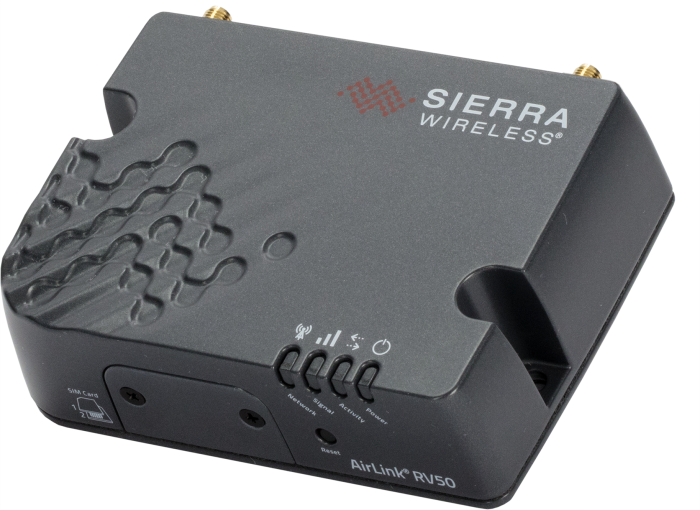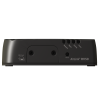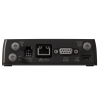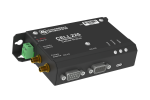This product is no longer available and has been replaced by: RV50X.

| 利用できるサービス |
|---|
概要
The RV50 is an industrial 4G LTE cellular gateway that provides serial and Ethernet connectivity to numerous cellular networks. (The RV50 automatically falls back to 3G or 2G when 4G coverage is not available.) The RV50 is capable of LTE, CDMA/EV-DO, and GSM/GPRS/EDGE/WCDMA networking and is carrier-approved worldwide for Verizon, AT&T, T-Mobile USA, Rogers, Bell, Telus, and other cellular data carriers. The networking and carrier used by the RV50 are determined by the active SIM card(s) inserted into the device.
Note: The RV50 does not ship with a SIM card unless the cellular modem was provisioned with/for Cellular Data Services; the SIM card is provided by the carrier when signing up for service.
続きを読む利点と特徴
- Easily provides Internet connectivity to Campbell Scientific data loggers and peripherals anywhere there is cellular network coverage
- Very low power consumption when compared to other industrial cellular gateways
- Compatible with most Campbell Scientific data loggers
- 4G LTE networking with automatic fallback to 3G and 2G
- Works with many cellular network carriers
- Ready to use out of the box—no need to work with a cellular carrier for modem provisioning and data plans when coupled with Campbell Scientific Data Services
イメージ











詳細
The RV50 is an industrial 4G LTE cellular gateway. It requires at least one mini-SIM (2FF) card supplied by your cellular carrier and a suitable 12 or 24 Vdc nominal power source. The RV50 has an RS-232 serial port that can be used for serial server, serial client, and PPP host services. This port is commonly connected to a data logger RS-232 serial port. Additionally, it has an Ethernet port, as well as a host of Ethernet and IP services related to routing, port forwarding, VPN, and more. The RV50 has three antenna connectors to be used for primary and diversity antennas and GPS, although the unit can operate with only the primary cellular antenna connected.
Internet Connectivity
The RV50 provides Internet connectivity to any Campbell Scientific data loggers located within range of a compatible cellular network. Armed with Internet connectivity, a data logger can remotely connect to Campbell Scientific software on a PC, mobile device, and the cloud. The RV50 can also enable many data loggers to communicate using other Internet protocols, such as Modbus, DNP3, email, and web (HTTP).
Device Intelligence
The RV50 is powered by the Sierra Wireless ALEOS embedded operating system. This allows the RV50 to provide highly reliable connectivity and remote device management independent of the device it is connected to. The numerous embedded services include IP serial server and client, local PPP host, dynamic DNS client, routing, VPN, and more.
Establishing Cellular Service
Campbell Scientific offers low-cost, cellular data service plans for the RV50. Our data service plans include Verizon in the United States and AT&T in North America (US, Mexico, Canada), as well as international access to over 600 carriers in 185 countries. The Konect Router Service is included to assure a secure connection with Campbell Scientific data logger support software.
Configuring the RV50
The RV50 is configured using ACEManager, a web-based configuration tool hosted by the gateway. ACEManager can be accessed using Internet Explorer or Firefox remotely over the cellular WAN or locally over Ethernet. A number of templates will be provided for download to make most configurations very simple after connection to ACEManager.
Data Logger Connection
Data loggers can be connected in a variety of ways to suit the needs of the application. Common methods include the use of serial or Ethernet peripherals. The 28899 Ethernet cable is shipped with the RV50 for connecting Ethernet devices.
Powering the RV50
Compared to many other industrial cellular gateways, the RV50 has a very low power consumption. The average current consumption at 12 Vdc is about 65 to 95 mA when idle, depending on its configuration. Additionally, the RV50 can be turned on and off easily using a data logger C, U, or SW12V port. When using the SW12V terminal, the modem can typically be powered with a BP12 battery, a CH150 charger/regulator, and a SP10 solar panel.
Antennas
Campbell Scientific offers two antennas for the RV50. Our higher gain omnidirectional (pn 32262) and Yagi (pn 31128) antennas require a cable to connect them to the RV50. The COAXSMA-L cable connects the antennas directly to the RV50 cellular antenna connector. The COAXNTN-L cable and a surge protector (pn 31317) are used when the RV50 is susceptible to lightning or electrostatic buildup or for long cable runs. Two external antennas are required for reliable 4G LTE communications.
仕様
| Transmission Distance or Area | Dependent upon antenna used and LTE, CDMA/EV-DO, GSM/GRPRS/EDGE, and WCDMA coverage. |
| Network Technology | 4G (with automatic fallback to 3G and 2G) |
| RF Connectors | 3 female SMA jacks (for primary cellular and optional diversity cellular and GPS) |
| Operating Temperature Range | -30° to +70°C |
| Host Interface |
|
| Service Requirements | Network coverage at the data logger site and cellular data service plan. |
| Dimensions | 11.9 x 9.4 x 3.4 cm (4.69 x 3.7 x 1.34 in.) |
| Weight | 320 g (11.3 oz) |
Cellular WAN - North American Model (-NA) |
|
| Carrier Approval | Verizon, AT&T, Sprint, T-Mobile USA, Rogers, Bell, Telus |
| LTE | 1900(B2), AWS(B4), 850(B5), 700(B13), 700(B17), 1900(B25) |
| WCDMA | 2100(B1), 1900(B2), AWS(B4), 850(B5), 900(B8) |
| EV-DO/CDMA | 800(BC0), 1900(BC1), 1700(BC10) |
| GSM/GPRS/EDGE | Quad-band |
| Industry Approvals | FCC, IC, PTCRB |
| Radio Type | Software-defined (with automatic network operator switching) |
| Interfaces | Dual SIM interfaces |
Cellular WAN - International Model (-INT) |
|
| LTE | 2100(B1), 1800(B3), 2600(B7), 900(B8), 800(B20) |
| WCDMA | 2100(B1), 1900(B2), 850(B5), 900(B8) |
| GSM/GPRS/EDGE | Quad-band |
| Industry Approvals | CE, RCM, GCF, R&TTE |
| Radio Type | Software-defined (with automatic network operator switching) |
| Interfaces | Dual SIM Interfaces (2FF) |
Power |
|
| Operating Voltage | 7 to 36 Vdc |
| Typical Enable/Ignition Sense Low | 1 mA (@ 12 Vdc) |
| Typical Idle | 65 to 95 mA (@ 12 Vdc, depending on configuration) |
| Typical Active | 250 to 300 mA (@ 12 Vdc, depending on configuration) |
互換性
Establishing Cellular Service
Ask your cellular provider for an M2M (machine-to-machine) account sales expert for the purpose of setting up either a publicly available static or dynamic IP account. You will need the sales expert to provide a mini-SIM card provisioned for your account.
Configuring the Modem
The RV50 is configured using ACEManager, a web-based configuration tool hosted by the gateway. ACEManager can be accessed using Internet Explorer or Firefox remotely over the cellular WAN or locally over Ethernet. A number of templates will be provided via download to make most configurations very simple after connecting to ACEManager.
Data Logger Consideration
The RV50 will connect to any Campbell Scientific devices that have an RS-232 serial or Ethernet port. Over the years, Campbell Scientific has created many serial and Ethernet products compatible with the RV50. In the following chart are product pairings that Campbell Scientific currently recommends:
| Data Logger | Connecting to RV50 RS-232, choose one | Connecting to RV50 Ethernet, choose one |
| CR300 |
|
|
| CR310 |
|
|
| CR6 and CR1000X |
|
|
| CR200(X) Series |
|
|
| CR800 and CR850 |
|
|
| CR1000 and CR3000 |
|
|
| CR5000 |
|
|
| CR510 and CR10X |
|
|
| CR510-PB and CR10X-PB |
|
|
| CR23X |
|
|
| CR23X-PB |
|
|
ドキュメント
マニュアル
ダウンロード
RV50(X) Firmware v.4.16.0.021 (46.3 MB) 20-12-2022
Currently this is the recommended RV50(X) firmware for use in Campbell Scientific applications. It is recommended that RV50(X) modems running older versions be updated.
RV50(X) Template Files (414 KB) 25-01-2021
For use with the Sierra Wireless RV50(X) modem.
These template files are used with the Sierra Wireless ACEManager to configure the AirLink RV50(X) modem to communicate at 115200 or 9600 baud with the datalogger. The templates will configure the RV50(X) for both serial server or PPP (point-to-point protocol) with the mode being determined by the datalogger. Using PPP allows access to the dataloggers IP capabilities (Email, HTTP, FTP, etc). The CR300, CR350, CR800, CR1000(X), CR3000 and CR6 dataloggers supports PPP.
Port forwarding for ports 80 and 6785 (HTTP and PakBus) is included in the template. Other needed ports (i.e. for Modbus and DNP3) will need to be added by the user through the RV50(X) ACEmanager interface.
Note: The download needs to be executed before use. The results of execution will place the template files in the "C:\RV50 Templates" directory on your computer.
ケーススタディ
2013 年、ルイジアナ州南部の歴史的な家屋の隣に陥没穴が出現しました。その後数か月で、陥没穴は深さ 30.5 メートル (100 フィート)、幅 61 メートル (200 フィート) にまで拡大しました。RESPEC は、不安定になる可能性のある斜面を監視するために、2014 年初頭に堅牢な伸縮計システムを設計、製造、設置しました。RESPEC は、システムのバックボーンとして、Campbell Scientific......続きを読む
GKM Consultants は、カナダの老朽化した高速道路高架道路向けに最先端の構造健全性監視システムを開発、運用、設置する業務を、国内有数のエンジニアリング会社から請け負いました。この監視システムは、リアルタイムで高品質のひずみデータを提供することで、構造物の寿命を延ばすのに役立ちます。 GKM は、構造物の桁に 72 個の振動線ひずみゲージ (Geokon モデル 4000) を設置しました。箔ひずみゲージは高速データ取得の一般的な選択肢ですが、その出力は時間の経過とともにドリフトする傾向があります。バイブレーティング線ひずみゲージは安定性が向上しているため、帯域幅が低いにもかかわらず、長期モニタリングに適しています。ひずみゲージは、エポキシ接着剤を使用して構造物に取り付けられることがよくあります。ただし、この方法は寒冷地での設置には適しておらず、接着剤とコンクリートの界面が劣化すると、数年後には測定値の比較が信頼できなくなります。長期モニタリングには、ドロップイン コンクリート アンカーを使用するのが望ましい方法ですが、標準的なアンカーは桁のウェブの厚さに対して長すぎます。そのため、この構造物の特殊な条件に対応するために、Geokon との協力によりカスタム アンカーを開発する必要がありました。ひずみゲージは、ひずみとせん断の両方を測定するためにロゼット パターンで設置されました。 データ収集システムは、Campbell......続きを読む
2012 年 8 月、RESPEC は、ルイジアナ州ナポレオンビル岩塩ドームの西側斜面で発生しつつある陥没穴に現場計測機器と早期警報監視サービスを提供する契約を締結しました。地下深くの塩水洞窟で構造的な亀裂が発生し、周囲の堆積物が洞窟に流れ込み、地表に陥没穴ができ、かき乱された堆積物からガスが放出されました。時間が経つにつれて、陥没穴は 40 エーカー以上に拡大し、最大深度では 400 フィートを超えました。 RESPEC のエンジニアは、発生しつつある陥没穴の周囲の傾斜と水位を継続的に監視するために、リアルタイムの早期警告システムを導入しました。陥没穴は沿岸のヒノキ沼地にあるため、監視システムは過酷な条件 (例: 猛暑、極度の湿度、ハリケーン、大雨、昆虫) で最小限のメンテナンスで稼働する必要がありました。このシステムは、Campbell Scientific のデータ......続きを読む
Privacy Policy Update
We've updated our privacy policy. 詳細はこちら
Cookie Consent
Update your cookie preferences. クッキーの設定を更新する








